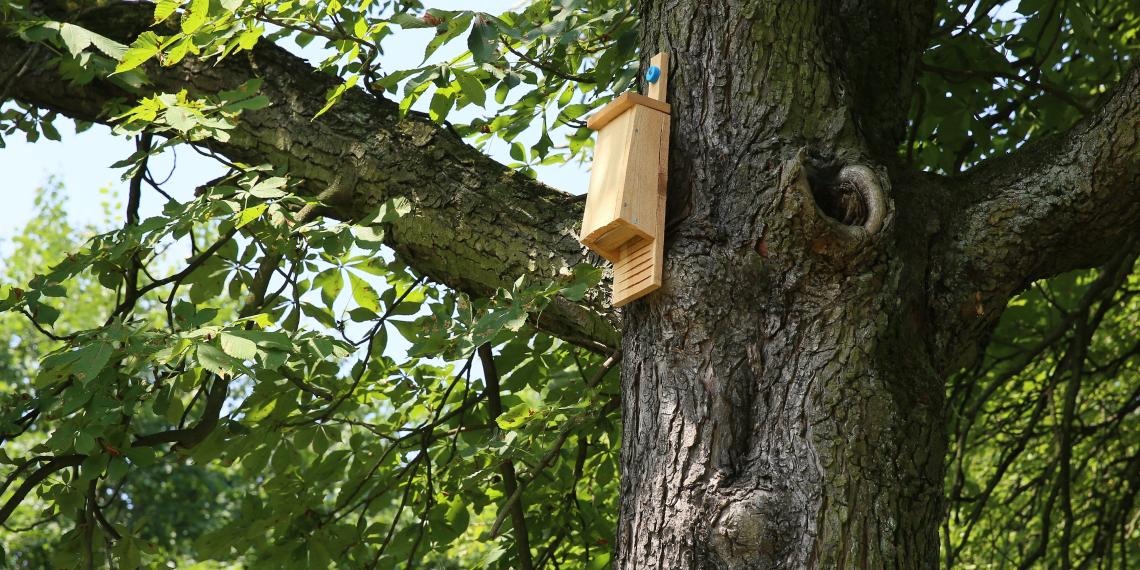Caledonian Horticulture is regularly posting ideas for ways in which you can help boost biodiversity in your local area, from simple everyday changes to nature projects in your garden. Today we are discussing bat boxes.
Why are bat boxes a good idea?
We have 18 species of bat in the UK, all of which are protected under European law and may use bat boxes. Some common species are Daubenton bat, lesser horseshoe bat, greater horseshoe bat, natterers bat, noctule bat and pipistrelle bat.
Bats naturally roost in gaps and crevices in trees like oak, beech, and ash, as well as in lofts, barns, caves, underground tunnels, and mines. However, many of our native bat species have suffered severe declines in the past century. They often struggle to find natural nesting sites, and so installing bat boxes in your area can be a great way to attract bat species and provide them with a home. Additionally, bats are important pollinators and can control pest insects for you, such as mosquitos, and their guano is an excellent fertiliser for your plants. So having them around is great!
Do I need permisson to install a bat box?
Anyone may put up bat boxes and undertake non-invasive checks of bat boxes (such as looking to see if bats are roosting) without needing a licence. However, if the box needs to be opened to check it then there must be a suitably licensed bat worker present. Anyone wishing to undertake bat box checks should obtain training in bat handling and identification before applying for a licence. You can find out more about licensing and bats on the Bat Conservation Trust website.
There are various designs of bat boxes; wooden boxes that you can make yourself, ready-assembled external boxes for buildings and trees, and even integrated bat boxes that can be built into walls. We recommend starting with wooden boxes that you can experiment with and see what species you can attract.
Single chamber boxes
These boxes consist of a single chamber with a ladder that is visible at the bottom to help the bats climb inside. It is also open at the bottom to prevent any build-up of guano.
All interior wood must be roughened for bats to readily cling to. The average bat box measurements are a minimum of two feet tall and 14 inches wide, and 3-5 inches deep to mimic natural spaces such as tree gaps. Boxes can be painted a dark colour to absorb heat from the sun and keep the bats warm.

Multiple slotted chamber boxes
This design is similar in overall shape and size to the single chamber boxes, but it has narrower and multiple chambers inside, rather than just one. It imitates niches where crevice-dwelling bats will roost such as a split in a tree.
The multiple chambers, increase capacity and allow bats to better regulate their temperature. These designs are ideal for pipistrelle bats and they can hold up to 50 individuals. By having slots that are different widths, this offers several species the choice to roost in this box. The boxes can be painted a dark colour to absorb heat from the sun and keep the bats warm.

Where to put bat boxes
The best place to hang a bat box is high up on the side of a building, in a rural area. Trees aren’t always the best place to hang a bat box, because predators like cats can reach them without effort.
Box designs should be located close to unlit linear features, such as lines of trees or hedgerows and no light should fall on the bat box itself or the adjacent habitat. Bat species use dark linear features for navigation between their roosting sites and feeding grounds and to avoid predation by flying in open and exposed areas.
Look for a spot that is sheltered from strong winds and exposed to the sun for part of the day. Ideally, they will be south-facing. If possible, place your bat box near a water source such as a pond, stream, or river. They should be positioned on a wall at least 2 metres high. Some foliage around the box or nearby will encourage it to be used.
Ensure the bat’s approach to the box is not impeded, for example by branches – clear away underneath the box so the bats can land easily before crawling up into the box.
When should I install my bat box?
Bat boxes can be installed at any time of year, but they are more likely to be used during their first summer if they are put up before the bats emerge from hibernation in the spring.
How can I attract bats to my bat box?
Introducing night-scented flowers around your gardens such as jasmine, honeysuckle, evening primrose, and sweet rocket can attract insects and moths which are food sources for bats. The more insects in your garden, the more likely that bats will visit and potentially use your bat box.

